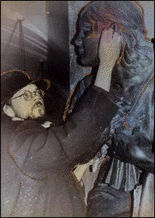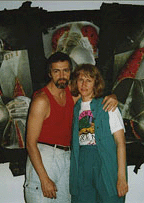The Metropolitan Museum of Cherkashin (Online Gallery)
GALLERY | BIO | ARTISTS’ STATEMENT | SOLO EXHIBITIONS | GROUP EXHIBITIONS
Valery and Natasha Cherkashin
(The Metropolitan Museum of Cherkashin)
26 Bakinskykh Komissarov, 4/1/10
117526, Moscow, Russia
tel: (095) 433 89 73
museum@sonnet.ru
www.geocities.com/SoHo/Museum/8000/
Valery and Natasha Cherkashin have been working with the imperial cultures of the USSR, Germany, the United States and Great Britain for more than 15 years. In 1992, the Cherkashins developed a conceptual art museum, the “Metropolitan Museum of Cherkashin.” The museum was named in honor of the Moscow Metro, one of the biggest memorials of Soviet time. The following documentation relates to a sequence of performances the Cherkashins staged in the Moscow subway between November 1990 and March 1993.
UNDERGROUND PRIVITIZATION
November 1990
The beginning of the epoch of privatization in Russia naturally had an effect onthe activities of the Metropolitan Museum. Especially because the process of privatization in art is an ancient and traditional form. Since our activity centers on the Moscow subway, we started there. First, 15 objects at the “Revolution Square” station were privatized. This was recorded in documents, in photographs and by the Italian “Super Channel.” We plan to continue the process of privatization of different objects of culture in other metro stations, at the Exhibition of Economic Achievements, and other memorials of the 30’s through the 50’s in the USSR. The station “Square of the Revolution” was chosen because all of the sculptures chosen for privatization were available in a quantity of four, so there would not be any arguments between owners who chose two twin brother sculptures. For example, N. Kolodzei and K. Brilling both liked a frontier guard with a dog. The commission was able to fulfill their wishes. That performance helped to turn our attention to forgotten images of the 30’s and 50’s in the USSR. For this action the Metropolitan Museum was decorated with its first ordinance, “The Ordinance of the Metro of the II Degree.”
UNDERGROUND SUBBOTNIK*
February 1992
The privatized objects and images demanded attention. That is why, in the good tradition of our recent past, the management of the Metropolitan Museum announced “Subbotnik,” that is a personal initiative to work for free and from the bottom of one¹s heart. Most of the new owners of the privatized objects and other cultural workers responded to that call. Muscovites and guests of the capital joined them with great enthusiasm. This process was also recorded by photographs and, this time, by Russian TV. The owners mostly took care of their property. For example T. Kolodzei cleaned her revolutionary sailor. He shined like gold. S. Kooskov, on the other hand, was not occupied with his privatized engineer. He preferred to look after a girl with a rifle gun and a badge stating, “Voroshilovsky Rifleman.” A drunken man who approached with the intention of beating us, after hearing my plan of agitation, joined us with zeal and surprised everyone with his enthusiasm. In the end, he himself stimulated the interest of two young passing boys, who then joined us also. This action helped our contemporaries to make friends with Soviet material objects from the 30’s and 50’s.
*Under the Soviet System there was a tradition of citizens volunteering to work from time to time for free on Saturdays (“subbotnik”).
THE PEOPLE’S LOVE OF “ART FOR THE PEOPLE”
June 1991
We wondered if our objects were able to reach and affect our contemporaries. A Russian model from Rome, Velena, willingly agreed to help us find out. The night she spent in the Metro did not pass calmly. There was a great deal of communication, love and openness in relation to imagery. This was evidently made possible by the powerful charm, beauty and all the other human qualities of Velena. You can see in the photographs how our privatized objects reacted and responded to all this, objects that had been rescued by our contemporaries from the depths of history. They all came alive, smiled, grew warm, and it was hard to believe that they came from Stalin’s steely times. Of course this was an extraordinary thing for many of our citizens to see. This is why when one of our trackmen saw a naked beauty in the arms of a bronze intellectual at 3 a.m., he went tumbling down the rails and disappeared into the tunnel. Love and humanity make everything warm and beautiful, and as you see, surprising. This was the result of this performance of a night of love and humanity.
ENGAGEMENT
February 1992
The privatization did not pass by without a trace. Irina, one of the owners, developed romantic feelings towardsher object. She said: “Once when I passed by the ŒSquare of the Revolution,¹ I suddenly thought ŒWhy, there is my object sitting there. My dear one!¹” And a warm feeling rose up in her soul. Irina associated with him more often than the others, and he began to show romantic feelings in response. His name, it turned out, was Vasily. Finally they decided to combine their fates in marriage. On February, 22, 1992, they were officially engaged but decided to put off the wedding for a while (Things happen this way in our hard times). Photographs recorded Irina’s happy smile and the confused, yet glad face of Vasily. Russian television once again recorded the happy event. In this way we became once again much more intimate with the by-gone epoch of Stalin.
THE UNDERGROUND WEDDING
January 1993
Preparations for the wedding took a long time, more than a year. The question was raised before the board of directors of the Metropolitan Museum: “How to unite this loving couple?” There were two ways. The first was to make Vasily alive (like Pygmalion in Greece). The second was to make Irina a sculpture, that is, to bronze her. We chose the second variant. At last the long awaited moment came. Thanks to the director of the Moscow Subway and Ostankino TV, the ceremony was official. The bride was in a special dress, her face, hands, clothes, all covered with bronze. There were a lot of press correspondents, champagne, signing of documents, a wedding party at the Bride’s house, presents, toasts… And thus it was at last accomplished: the past and present flowed together into one. Hurrah! For this action, the Museum Metropolitan received its second Ordinance, “The Ordinance of the Metro of the First Degree.”
THE UNDERGROUND BEAUTY CONTEST, MISS 38
March 1993
After the wedding, life resumed its normal process for the underground objects. In March 1993, however, in honor of International Women’s day, the board of directors of the Metropolitan Museum, together with the Moscow bureau of the German magazine Stern, its editor K. Gloger, and the excellent photographer H.U. Burkard, staged the performance “Beauty Contest Miss Œ38” in the “Revolution Square” metro station, featuring six women and girls from the 1930’s. From them three were to be chosen: “Miss 38” was the first; “Miss Photo-Model” was the second; and “Miss Passenger’s Sympathies” was the third. The passengers of that difficult time, naturally, chose the female worker with the chicken and rooster and an apron full of something tasty. The committee of 10 voted for “Miss 38” by tossing secret ballots (as it seemed to them) into an urn. However, as would have been appropriate in the epoch we are dealing with, the choice of “Miss 38” was handed down from above. She had to be the woman of proven ability with the rifle and the badge saying “Voroshilovsky Rifleman.” The committee was then left to choose “Miss Photo-Model.” She turned out to be the almost naked girl-sportsman with a disk in her hand. The contest was conducted in a businesslike and serious atmosphere. For this action, the Metropolitan Museum at last received the title it had long been fighting for: that of “All Union.”
1998
Empires: Russia past & present.Center for Contemporary Arts (with Bill Wright and Steve Yates) Abilene, TX.
Favorite Portraits of People in the World. The World Bank, Washington DC, USA.
The most favorite portrait of people in the world. Underwater show in the bath. New York.
The End of the Epoch. Installation. The World Bank, Washington DC, USA.
Russia/America: Mirages of Empires. Chevy Chase Art Center, Washington DC, USA.
Favorite Portraits of People in the World. Citibank, Washington DC, USA.
Mirages of Empires. Dickinson College, PA, USA.
The Last Pravda. Moscow State University. Moscow.
Russians and Americans Brothers forever. American Cultural Center. Moscow.
Moscow from 30s to 50s. Art department, Library of Foreign Literature, Moscow.
1997
USSR Atlantis. Swimming pool. University of Maryland. USA.
The End of the Epoch. Kunstverein Rosenheim. Germany. (catalogue).
Moscow – Washington. Carnegie Moscow Center. Moscow.
The Mystery Play of Berlin. The Goethe Institute. Moscow. (catalogue).
1996
Moscow. The End of the Epoch. The Ford Foundation. Moscow.
Mirages of Empire. The Russian House Berlin.
German Atlantis. Underwater exhibition. Olympia Stadium. Berlin.
1995
Russians and Americans – Brothers Forever. Together with Steve Yates. Municipal A – 3 Gallery. Moscow (catalogue).
1994
Moscow¹s Red Square in Santa Fe. Curator Steve Yates.
Museum of Fine Arts, Santa Fe, NM, USA. (catalogue) .
1993
Under Cover. IBM Office, Moscow.
The Museum Metropolitan of Cherkashin with an Art Collection of Socialism Realism of the 30ís to the 60s. Kremlin, Palace of Congresses, Moscow.
Museum Metropolitan of Cherkashin. Presentation . Municipal A – 3 Gallery, Moscow.
(Album ).
1991
The end of the Epoch, the 90s, Library of Foreign Literature. Moscow.
1985
The Maltese Embassy. Moscow.
1984
The Museum of Architecture. Moscow.
1998
Russian Constructivist Ruts: Present concerns. University of Maryland, University of New Hampshire; Dickinson College, PA; The World Bank, Washington DC, USA. (catalog).
1997
From Rodchenko to our days. Museum of Photographic Collections, Moscow.
850 Anniversary of Moscow. Municipal A-3 Gallery, Moscow.
1996
New Russian Art from Kolodzei collection. Georgetown University, Washington DC.
Die Grosse Zurcher Ausstellung. Kunsthaus Oerlikon, Zurich.
1995
New Acquirements. Museum of Fine Arts, Santa Fe, New Mexico.
Collects of Olga Hirshhorn. The Corcoran Gallery, Washington DC.
1994-1995
New Photoart from Russia. Karlsruhe, Frankfurt, Hanover, Dusseldorf .(catalogue).
4+4 Late Modern. Museum of Fine Arts, Santa Fe, New Mexico, USA (catalogue).
Works on paper from the Kolodzei Collection. Oklahoma City, USA.
1993
Art of Contemporary Photography. Central House of Artists, Moscow, Russia. (catalogue).
1992
Europe-America 500. Kolodzei Art Foundation, Seattle, USA.
Malevich Center. Museum of Paleontology, Moscow.
To Malevich. Karenina Gallery, Vienna (catalogue).
1990
Artists developing the style of Malevich. Tretjakow Gallery, Moscow.
Moscow in Cambridge. Cambridge, Great Britain.
Traditions of Russian Paintings. Museum of Reconstruction, Moscow.
1989
One Hundred Artists from the Kolodzei Collection . State Museum, Tashkent.








